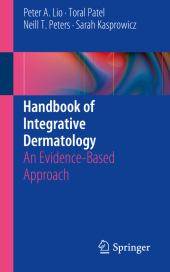 Neuerscheinungen 2015Stand: 2020-02-01 |
Schnellsuche
ISBN/Stichwort/Autor
|
Herderstraße 10
10625 Berlin
Tel.: 030 315 714 16
Fax 030 315 714 14
info@buchspektrum.de |

Sarah Kasprowicz, Peter A. Lio, Toral Patel
(Beteiligte)
Handbook of Integrative Dermatology
An Evidence-Based Approach
1st ed. 2015. 2015. xviii, 226 S. 22 SW-Abb. 203 mm
Verlag/Jahr: SPRINGER, BERLIN; SPRINGER INTERNATIONAL PUBLISHING 2015
ISBN: 3-319-17815-6 (3319178156)
Neue ISBN: 978-3-319-17815-8 (9783319178158)
Preis und Lieferzeit: Bitte klicken
This user-friendly reference tool presents clinical scenarios and discusses some practical complementary and alternative therapies available in dermatology. It focuses on peer-reviewed data that are suitable for use in a conventional dermatology practice and helps dermatologists guide their patients when faced with questions regarding integrative dermatology using an evidence-based, reader-friendly, and case-focused approach. Within the field of dermatology, there is a marked void in the understanding of complementary and alternative approaches, though dermatologists frequently use off-label therapies to manage chronic conditions. They do so, however, with a range of success and potentially considerable side effect profiles. Handbook of Integrative Dermatology is a must-have tool for any practicing dermatologist.
Preface; 1. Introduction to Integrative Dermatology; 2. General skin care and promoting healthy skin; 3. Sun protection; 4. Skin Cancer; 5. Acne; 6. Rosacea; 7. Hair loss; 8. Psoriasis; 9. Atopic Dermatitis/Eczema; 10. Urticaria and Angioedema; 11. Disorders of Pigmentation; 12. Warts and Molluscum; 13. Fungal and Bacterial Infections; 14. Seborrheic dermatitis; 15. Pruritus (Itch); 16. Resources
"The purpose is to educate dermatologists in alternative/complementary medical therapies for treating various skin disorders. ... This book enables us to be a bit more informed about alternative, unconventional approaches to common dermatological diseases and references studies that support/suggest their potential usefulness. If we are better informed, we can help our patients explore treatment options that are perceived as more healthful and well rounded." (Patricia Wong, Doody´s Book Reviews, January, 2016)


